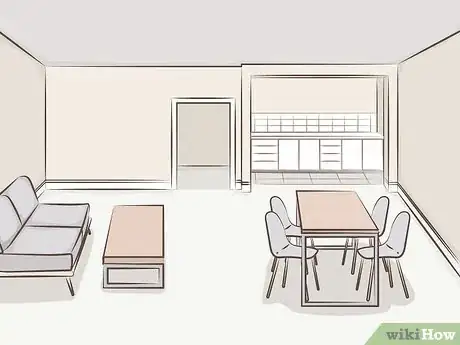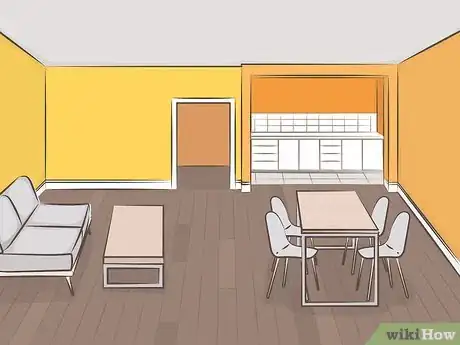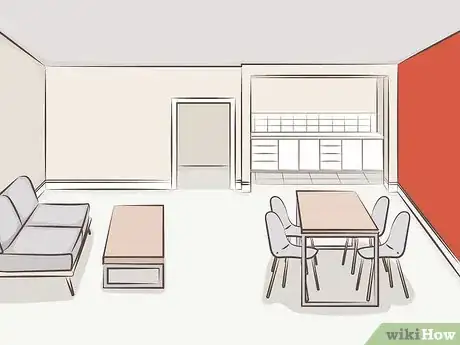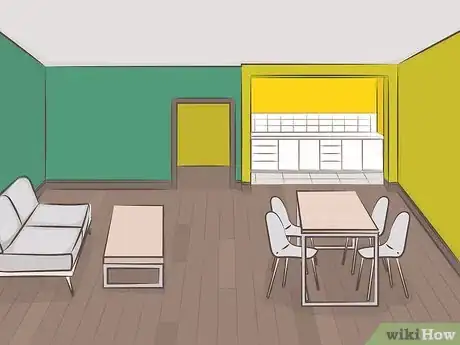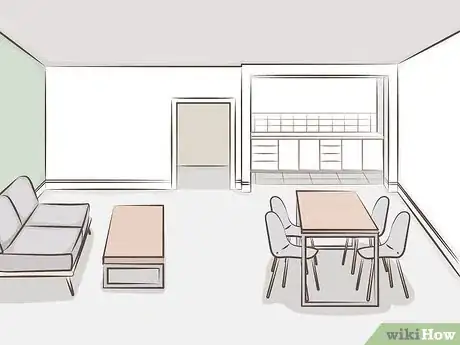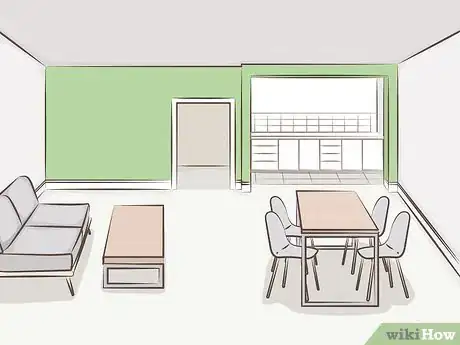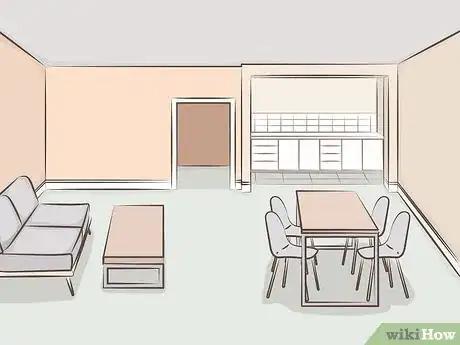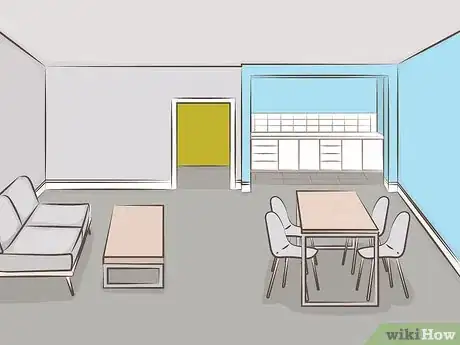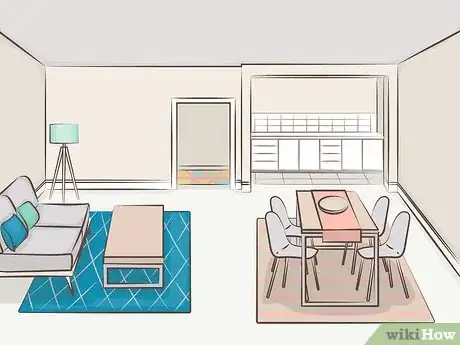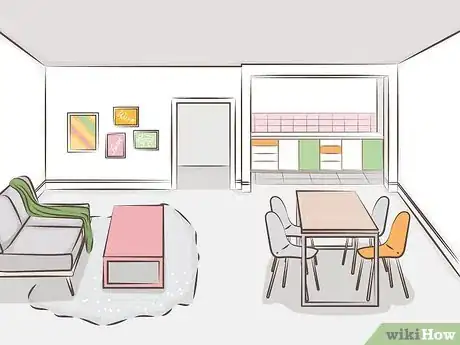This article was co-authored by Juli Roland and by wikiHow staff writer, Amber Crain. Juli Roland is a Color Specialist and the Founder of PaintColorHelp.com, one of the first companies in Dallas, Texas metro area that provides in-home color consultations and helps clients create paint color schemes. Juli has over 15 years of commercial and residential color consulting experience, including seven years as a custom-matcher in the paint industry. She earned her certification in color strategy from Camp Chroma and is a member of the Inter-Society Color Council. She has a BA in Advertising from Texas Tech University.
There are 7 references cited in this article, which can be found at the bottom of the page.
This article has been viewed 13,968 times.
Painting an open floor plan presents a unique issue for homeowners. Ideally, you want to create a feeling of consistency throughout your space but also include enough variety to separate the different areas from one another. To accomplish this, it's all about choosing the right paint color palette! You have tons of options when it comes to color, so go with what works best for your space and home decor.
Steps
Color Palettes
-
1Keep it simple and use a single paint color for a cohesive look. Using color in open floor plans can be tricky! When in doubt, choose a single paint color and use it throughout your home. This takes all of the guesswork out of your task and creates a consistent, harmonious space.[1]
- For example, select a simple color, like cream, and use that for every wall.
-
2Use different shades of the same color for an easy way to add variety. If a single paint color sounds too boring for you, choose 1 base color and buy paint in several different shades or tones. A monochromatic theme can help you create more visual interest without sacrificing an overall sense of unity.[2]
- For example, use cream in the dining room, pastel yellow in the kitchen, and a sunny yellow in the living room.
- Try using 2-3 different shades of gray to add variety to a neutral color scheme.
Advertisement -
3Go with cool, light colors to create the illusion of more space. It’s common to find open floor plans in small spaces, like 1-bedroom and efficiency apartments. Using light, airy paint colors, like white or light gray, can make the space feel bigger.[3]
- For example, use a cool, light gray in an efficiency apartment to open up the space.
- Incorporate pale shades of cool colors like blue, green, or lavender for more variety.
-
4Use a warm color palette if you want a cozy atmosphere. Yellows, reds, oranges, reddish purples, and browns are warm colors. Generally, warm colors make spaces feel welcoming, intimate, and cozy.[4] If that's what you're going for, build your color palette with warm colors.[5]
- For example, make a foyer feel intimate by using rustic orange or red paint.
- Use a warm color, like yellow, to bring out the natural warmth of hardwood floors.
- Warm colors tend to work well together. Feel free to choose multiple colors or stick with different shades of the same color.
-
5Add a bold color to a neutral palette as an accent color. Neutral palettes are easy to work with, but they can feel a little dull. Inserting a bold color into the palette can liven things up a bit! Use the bold color to create accents and focal points in your space.[6]
- For example, if your neutral palette is beige and caramel, bring out the warmth of those colors by adding a bold red or pumpkin into the mix.
- A bold blue can underscore cool tones and add a pop of color to an all-gray palette.
-
6Select shades of equal intensity for an energetic atmosphere. Saturated colors in your palette create a dynamic, active vibe. Going with saturated colors of equal intensity keep the overall effect balanced. This is great for activity-oriented areas like the kitchen.[7]
- For example, medium shades of yellow, green, and chartreuse make a lively, cohesive palette.
- If you're looking at paint strips in a home improvement store, the saturated hues are usually on the bottom of the strip. The lightest colors appear at the top.
Painting Techniques
-
1Highlight a specific area by painting an accent wall. An accent wall adds a pop of color and makes a specific area stand out. The accent wall can be a subtle color shift or something more eye-catching, depending on the effect you want to create.[8]
- For a subtle solution, use white paint throughout your space and a pale greyish-green for the accent wall.
- For a pop of color, paint a canary yellow wall amid neutral tans and browns.
-
2Paint adjoining walls the same color for a seamless flow. If you’re concerned about creating harsh, unwelcoming lines between “rooms” or spaces, paint all of the adjoining walls the same color. This technique leads the eye and flows naturally from area to area.[9]
-
3Create defined but smooth transitions with subtle color shifts. Sharp color contrasts right next to each other can feel harsh and abrupt in an open floor plan. Use colors that subtly shift in tone to mark separate spaces without losing an overall sense of harmony.[10]
- For example, a cream wall in the kitchen can subtly shift into a light tan wall in the living room.
-
4Use palette colors in varying amounts to define separate areas. To maintain a sense of unity while also adding personality to each "room," switch up how and where you apply your color palette in each area. Repeating the same colors creates unity but changing up the application makes each space unique.[11]
- For example: paint the kitchen light gray, the trim blue, and accent with brown. Then, paint the living room blue, use brown trim, and accent with gray.
- For a neutral palette: use cream for the kitchen walls, tan for the trim, and brown for the cabinets. In the living room, go with tan walls, brown trim, and cream accents.
-
5Use a consistent trim color to unify areas with different wall colors. If you’re using different colors throughout your space, be consistent with the color of your trim to pull everything together. This creates a seamless flow and makes everything look cohesive.[12]
- For example, use white trim in both spaces to unite a pale blue kitchen and light gray living room.
Furniture and Decor
-
1Define separate spaces with a variety of colorful area rugs. If you want to create individual spaces in your open floor plan, put down a variety of area rugs that tie in nicely with the paint and other décor. The rugs demarcate each area and add visual interest to each space.[13]
- For example, place a rug that's a few feet wider than your front door in your foyer. The rug helps to visually defines the entryway.
- Create a variety of effects by changing up the color, pattern, texture, and size of the rugs.
-
2Use pops of color in your decor to liven up plain or neutral paint. White or beige walls make great backdrops because they match almost everything. If your walls look plain, add pops of color with your decor and furniture to create a little more drama in your space.[14]
- For example, if you have white walls, add pops of color with shades of green, pink, and orange.
-
3Open up small spaces with light-colored furniture and decor. Light colors can create the illusion of space in a small area. If you painted your home light, airy colors like white, light gray, or pale blue, continuing that color scheme with furniture and decor can make an area feel even more spacious.[15]
-
4Rearrange furniture to create the illusion of individual spaces. Where you place your furniture can make a huge difference in an open floor plan. For example, to visually separate the kitchen area from the living room, try positioning an oblong dining table in between the areas.[16]
- After separating the spaces, you can decorate them differently to make them even more unique and separate.
Expert Q&A
-
QuestionHow do you paint a long, narrow room?
 Juli RolandJuli Roland is a Color Specialist and the Founder of PaintColorHelp.com, one of the first companies in Dallas, Texas metro area that provides in-home color consultations and helps clients create paint color schemes. Juli has over 15 years of commercial and residential color consulting experience, including seven years as a custom-matcher in the paint industry. She earned her certification in color strategy from Camp Chroma and is a member of the Inter-Society Color Council. She has a BA in Advertising from Texas Tech University.
Juli RolandJuli Roland is a Color Specialist and the Founder of PaintColorHelp.com, one of the first companies in Dallas, Texas metro area that provides in-home color consultations and helps clients create paint color schemes. Juli has over 15 years of commercial and residential color consulting experience, including seven years as a custom-matcher in the paint industry. She earned her certification in color strategy from Camp Chroma and is a member of the Inter-Society Color Council. She has a BA in Advertising from Texas Tech University.
Certified Color Specialist If you have a long, narrow room, try painting one of the narrow walls a darker, bolder color. That can help the room seem wider and more balanced.
If you have a long, narrow room, try painting one of the narrow walls a darker, bolder color. That can help the room seem wider and more balanced. -
QuestionWhat colors should I paint my open floor plan?
 Juli RolandJuli Roland is a Color Specialist and the Founder of PaintColorHelp.com, one of the first companies in Dallas, Texas metro area that provides in-home color consultations and helps clients create paint color schemes. Juli has over 15 years of commercial and residential color consulting experience, including seven years as a custom-matcher in the paint industry. She earned her certification in color strategy from Camp Chroma and is a member of the Inter-Society Color Council. She has a BA in Advertising from Texas Tech University.
Juli RolandJuli Roland is a Color Specialist and the Founder of PaintColorHelp.com, one of the first companies in Dallas, Texas metro area that provides in-home color consultations and helps clients create paint color schemes. Juli has over 15 years of commercial and residential color consulting experience, including seven years as a custom-matcher in the paint industry. She earned her certification in color strategy from Camp Chroma and is a member of the Inter-Society Color Council. She has a BA in Advertising from Texas Tech University.
Certified Color Specialist Colors like blues and greens are thought to be good colors for improving focus and concentration.
Colors like blues and greens are thought to be good colors for improving focus and concentration. -
QuestionWhat colors can I use to make my house feel more inviting?
 Juli RolandJuli Roland is a Color Specialist and the Founder of PaintColorHelp.com, one of the first companies in Dallas, Texas metro area that provides in-home color consultations and helps clients create paint color schemes. Juli has over 15 years of commercial and residential color consulting experience, including seven years as a custom-matcher in the paint industry. She earned her certification in color strategy from Camp Chroma and is a member of the Inter-Society Color Council. She has a BA in Advertising from Texas Tech University.
Juli RolandJuli Roland is a Color Specialist and the Founder of PaintColorHelp.com, one of the first companies in Dallas, Texas metro area that provides in-home color consultations and helps clients create paint color schemes. Juli has over 15 years of commercial and residential color consulting experience, including seven years as a custom-matcher in the paint industry. She earned her certification in color strategy from Camp Chroma and is a member of the Inter-Society Color Council. She has a BA in Advertising from Texas Tech University.
Certified Color Specialist In general, colors from the "warm" side of the color wheel are more welcoming. That includes yellows, oranges, pinks, reds, and near-neutrals from those same color families, like gold, beige, and greige.
In general, colors from the "warm" side of the color wheel are more welcoming. That includes yellows, oranges, pinks, reds, and near-neutrals from those same color families, like gold, beige, and greige.
References
- ↑ https://www.bobvila.com/slideshow/own-your-open-floor-plan-with-8-smart-design-tricks-48966
- ↑ https://www.bhg.com/decorating/color/basics/5-ways-to-connect-rooms-with-color/
- ↑ https://www.thisoldhouse.com/painting/21017932/no-fail-paint-colors-for-small-spaces
- ↑ Juli Roland. Certified Color Specialist. Expert Interview. 27 March 2020.
- ↑ https://www.thisoldhouse.com/painting/21017932/no-fail-paint-colors-for-small-spaces
- ↑ https://www.thisoldhouse.com/painting/21018150/refresh-your-rooms-with-bold-color-combinations
- ↑ https://www.thisoldhouse.com/painting/21018150/refresh-your-rooms-with-bold-color-combinations
- ↑ https://www.thisoldhouse.com/painting/21018150/refresh-your-rooms-with-bold-color-combinations
- ↑ https://www.bhg.com/rooms/living-room/room-arranging/open-floor-plans/
- ↑ https://www.bhg.com/rooms/living-room/room-arranging/open-floor-plans/
- ↑ https://www.bhg.com/decorating/color/basics/5-ways-to-connect-rooms-with-color/
- ↑ https://www.bhg.com/decorating/color/basics/5-ways-to-connect-rooms-with-color/
- ↑ https://www.thisoldhouse.com/living-rooms/21395694/how-to-create-an-open-floor-plan
- ↑ https://www.bhg.com/rooms/living-room/room-arranging/open-floor-plans/
- ↑ https://www.thisoldhouse.com/living-rooms/21395694/how-to-create-an-open-floor-plan
- ↑ https://www.thisoldhouse.com/living-rooms/21395694/how-to-create-an-open-floor-plan
